Belkin F5D7231C Wireless G Plus Router User Manual 07 366 DX WEGRTR combined
Belkin International, Inc. Wireless G Plus Router 07 366 DX WEGRTR combined
Belkin >
Contents
user manual prod 1 part 1

USER GUIDE
GUIDE DE L’UTILISATEUR • GUÍA DEL USUARIO
Wireless Enhanced G Router
Routeur sans fil G amélioré
Enrutador inalámbrico G mejorado
DX-WEGRTR

2Contents
Dynex DX-WEGRTR
Wireless Enhanced G Router
Contents
Introduction ......................................................................................2
Product features................................................................................3
Setting up your wireless router..........................................................9
Troubleshooting ..............................................................................47
Legal notices ...................................................................................58
One year limited warranty...............................................................61
Français ...................................................63
Español..................................................131
Introduction
Thank you for purchasing the Dynex DX-WEGRTR Wireless Enhanced G Router. The easy
installation and setup will have you networking wirelessly in minutes. Be sure to read
through this User Guide completely, and pay special attention to the section entitled
“Placement of your router for optimal performance” on page 47.
Benefits of a home network
Your home network will let you:
• Share one high-speed Internet connection with all the computers in your home
• Share resources, such as files, and hard drives among all the connected computers in
your home
• Share a single printer with the entire family
• Share documents, music, video, and digital pictures
• Store, retrieve, and copy files from one computer to another
• Simultaneously play games online, check Internet e-mail, and chat

Product features 3
Advantages of a wireless network
Here are some of the advantages of setting up a Dynex wireless network:
•Mobility–you will no longer need a dedicated “computer room”— now you can work
on a networked laptop or desktop computer anywhere within your wireless range
•Easy installation–Dynex Easy Installation Wizard makes setup simple
•Flexibility–set up and access printers, computers, and other networking devices from
anywhere in your home
•Easy expansion–the wide range of Dynex networking products lets you expand your
network to include devices such as printers and gaming consoles
•No cabling required–you can spare the expense and hassle of retrofitting Ethernet
cabling throughout the home or office
•Widespread industry acceptance–choose from a wide range of interoperable
networking products
Product features
In minutes you will be able to share your Internet connection and network your computers.
The following is a list of features that make your new Dynex wireless enhanced G router an
ideal solution for your home or small office network.
Works with Both PCs and Mac® Computers—The router supports a variety of
networking environments including Mac OS®, X v10.x, Linux®, Windows® 2000, XP, Vista™,
and others. All that is needed is an Internet browser and a network adapter that supports
TCP/IP (the standard language of the Internet).
Front-Panel LED Display—Lighted LEDs on the front of the router indicate which
functions are in operation. You'll know at-a-glance whether your router is connected to the
Internet. This feature eliminates the need for advanced software and status-monitoring
procedures.
Web-Based Advanced User Interface—You can set up the router's advanced functions
easily through your web browser, without having to install additional software onto the
computer. There are no disks to install or keep track of and you can make changes and
perform setup functions from any computer on the network quickly and easily.
NAT IP Address Sharing—Your router employs Network Address Translation (NAT) to share
the single IP address assigned to you by your Internet Service Provider while saving the cost
of adding IP addresses to your Internet service account.
SPI Firewall—Your router is equipped with a firewall that will protect your network from a
wide array of common hacker attacks including IP Spoofing, Land Attack, Ping of Death
(PoD), Denial of Service (DoS), IP with zero length, Smurf Attack, TCP Null Scan, SYN flood,
UDP flooding, Tear Drop Attack, ICMP defect, RIP defect, and fragment flooding.
Integrated 10/100 4-Port Switch—The router has a built-in, 4-port network switch to
allow your wired computers to share printers, data and MP3 files, digital photos, and much
more. The switch features automatic detection so it will adjust to the speed of connected
devices. The switch will transfer data between computers and the Internet simultaneously
without interrupting or consuming resources.

4Product features
Universal Plug-and-Play (UPnP) Compatibility—UPnP (Universal Plug-and-Play) is a
technology that offers seamless operation of voice messaging, video messaging, games, and
other applications that are UPnP-compliant.
Support for VPN Pass-Through—If you connect to your office network from home using
a VPN connection, your router will allow your VPN-equipped computer to pass through the
router and to your office network.
Built-In Dynamic Host Configuration Protocol (DHCP)—Built-In Dynamic Host
Configuration Protocol (DHCP) on-board makes for the easiest possible connection of a
network. The DHCP server will assign IP addresses to each computer automatically so there is
no need for a complicated networking setup.
Easy Install Wizard—The Easy Install Wizard takes the guesswork out of setting up your
router. This automatic software determines your network settings for you and sets up the
router for connection to your Internet Service Provider (ISP). In a matter of minutes, your
wireless router will be up and running on the Internet.
Note: Easy Install Wizard software is compatible with Windows 2000, XP, Vista, and Mac OS
Mac OSx 10.4.x. If you are using another operating system, the wireless router can be set
up using the Alternate Setup Method described in this User Guide (see Alternate setup
method on page 15.
Enhanced G Mode*–Enhanced G Mode, a 54g performance enhancement, provides the
fastest wireless connectivity for 802.11g-capable networks in real-world environments. It is
designed for home networks that require additional bandwidth for applications such as
sharing digital pictures. Enhanced G makes 802.11g WLANs more efficient without affecting
the performance of neighboring networks, and is compatible at high speeds with leading
brands.
*When operating in 125 Enhanced G Mode, this Wi-Fi device achieves an actual throughput
of up to 34.1 Mbps, which is the equivalent throughput of a system following 802.11g
protocol and operating at a signaling rate of 125 Mbps. Actual throughput will vary
depending on environmental, operational, and other factors.
Integrated 802.11g Wireless Access Point—802.11g is an exciting new wireless
technology that achieves data rates up to 54 Mbps, nearly five times faster than 802.11b.
MAC Address Filtering—For added security, you can set up a list of MAC addresses (unique
client identifiers) that are allowed access to your network. Every computer has its own MAC
address. Simply enter these MAC addresses into a list using the Web-Based Advanced User
Interface and you can control access to your network.
Package contents
• Dynex Wireless Enhanced G Router
• Quick Installation Guide
• Installation software CD
• RJ-45 Ethernet cable
• Power supply
•User Guide

Product features 5
System requirements
• Broadband Internet connection such as a cable or DSL modem with RJ45 (Ethernet)
connection
• At least one computer with an installed network interface adapter
• TCP/IP networking protocol installed on each computer
• RJ-45 Ethernet networking cable
• Internet browser
Easy Install Wizard Software System Requirements
• A PC running Windows 2000, XP, or Vista, or a Mac computer running Mac OSx 10.4x
• A minimum 64 MB RAM
• An Internet browser
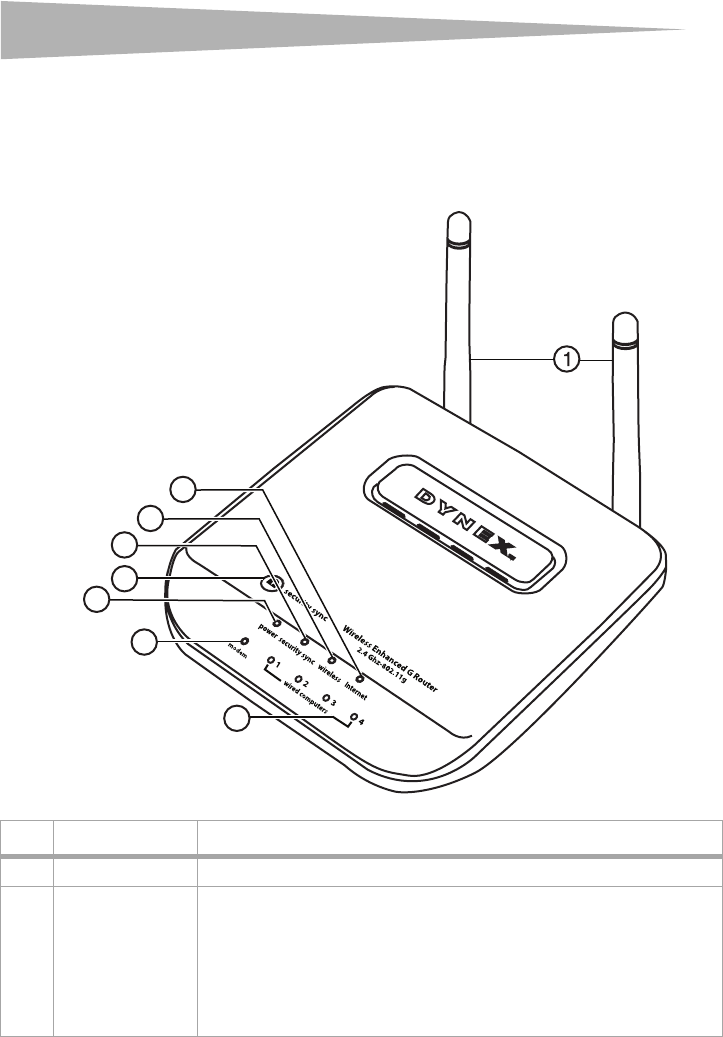
6Product features
Components
The router has been designed to be placed on a desktop. All of the cables exit from the rear of
the router for better organization and utility. The LED indicators are easily visible on the front
of the router to provide you with information about network activity and status.
Front panel
# Component Description
1 Antennas Lets the router communicate with a wireless client (card or USB adapter).
2 Power/ready LED When you apply power to the router or restart it, a short period of time elapses while
the router boots up. During this time, the Power/Ready LED blinks. When the Router
has completely booted up, the Power/Ready LED becomes a SOLID light, indicating
the router is ready for use.
Off—Router is off
Blinking Green—Router is booting up
Solid Green—Router is ready
2
7
4
5
8
6
3

Product features 7
3 Security Sync button Push and hold this button for three seconds, then initiate the Security Sync (WPS)
procedure on the client device within two minutes. Your client will automatically
exchange the security information and be added to your wireless network. Pushing
the Security Sync button will automatically enable WPS. See “Using Security Sync
(Wi-Fi Protected Setup)” on page 28.
4 Security Sync LED Lights to indicate that WPS has been activated.
Blinking Green—The router is searching for a WPS client to connect with.
Solid Green—The secure connection has been established with the client.
4 Wireless network LED Off—The wireless network is off
Solid Green—The wireless network is ready
Blinking Green—Network activity
5 Internet LED This unique LED shows you when the router is connected to the Internet. When the
light is OFF, the router is not connected to the Internet. When the light is blinking,
the router is attempting to connect to the Internet. When the light is solid green, the
router is connected to the Internet. When using the “Disconnect after x minutes”
feature, this LED becomes extremely useful in monitoring the status of your router's
connection.
Off—Router is not connected to the Internet
Blinking Green—Router is attempting to connect to the Internet
Solid Green—Router is connected to the Internet
6 Modem status LED This LED lights green to indicate that your modem is connected properly to the
router. It blinks rapidly when information is being sent over the port between the
router and the modem.
Off—No WAN link
Solid Green—Good WAN link
Blinking Green—WAN activity
7 Wired computer
status LEDs These LEDs are labeled 1-4 and correspond to the numbered ports on the rear of the
router. When a computer is properly connected to one of the wired computer ports
on the rear of the router, the LED will light. green means a 10Base-T device is
connected, orange means a 100Base-T device is connected. When information is
being sent over the port, the LED blinks rapidly.
Off—The wireless network is off
Solid Green—A 10base-T device is connected
Solid Orange—A 100base-T device is connected
Blinking—Port activity
# Component Description
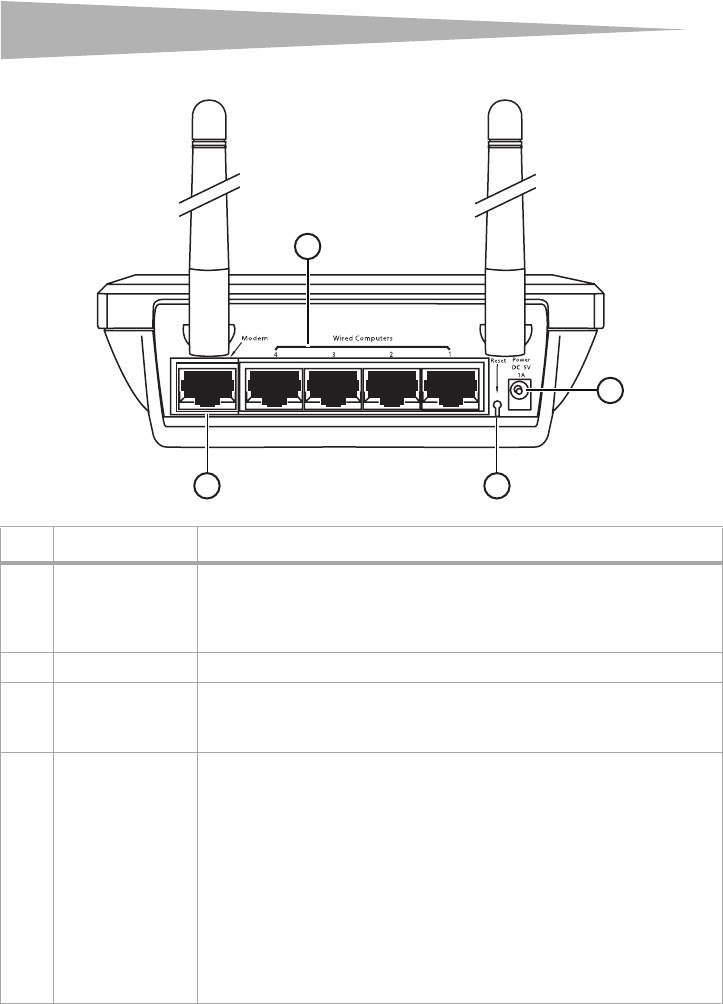
8Product features
Back panel
# Component Description
1 Wired computer
ports - Blue Connect your wired (non-wireless) computers to these ports. These ports are RJ-45,
10/100 auto-negotiation, auto-uplinking ports for standard UTP category 5 or 6
Ethernet cable. The ports are labeled 1 through 4. These ports correspond to the
numbered LEDs on the front of the router.
2 Power jack The 5 V DC power supply plugs into this jack.
3 Modem port - Green This port is for connection to your cable or DSL modem. Use the cable that was
provided with the modem to connect the modem to this port. Use of a cable other
than the cable supplied with the cable modem may not work properly.
4 Reset button The Reset button is used in rare cases when the router may function improperly.
Resetting the router restores the router's normal operation while maintaining the
programmed settings. You can also restore the factory default settings by using the
Reset button. Use the restore option in instances where you may have forgotten your
custom password.
Resetting the router—Push and release the Reset button. The lights on the
router will momentarily flash. The Power/Ready light will begin to blink. When the
Power/Ready light becomes solid again, the reset is complete.
Restoring the Factory Defaults—Press and hold the Reset button for at least 10
seconds, then release it. The lights on the router will momentarily flash. The Power/
Ready light will begin to blink. When the Power/Ready light becomes solid again,
the restore is complete.
1
3
2
4

Setting up your wireless route
r
9
Setting up your wireless router
Modem requirements
Your cable or DSL modem must be equipped with an RJ-45 Ethernet port. Many modems
have both an RJ-45 Ethernet port and a USB connection. If you have a modem with both
Ethernet and USB, and are using the USB connection at this time, you will be instructed to
use the RJ-45 Ethernet port during the installation procedure. If your modem has only a USB
port, you can request a different type of modem from your ISP, or you can, in some cases,
purchase a modem that has an RJ-45 Ethernet port on it.
Important: Always install your router first! if you are installing numerous network devices
for the first time, it is important that your router is connected and running before
attempting to install other network components such as notebook cards and desktop
cards.
Setup assistant
Dynex has provided our Setup Assistant software to make installing your router a simple and
easy task. You can use it to get your router up and running in minutes. The Setup Assistant
requires that your Windows 2000 or XP computer be connected directly to your cable or DSL
modem and that the Internet connection is active and working at the time of installation. If it
is not, you must use the “Alternate Setup Method” section of this User Guide to configure
your router. Additionally, if you are using an operating system other than Windows 2000 or
XP, you must set up the router using the “Alternate Setup Method” section of this User Guide.
Hardware connections
To connect the hardware:
1Unplug your modem's power cord. Put the router next to the modem and raise the
router's antennas.
2Locate the networking cable that connects your modem and computer. Unplug that
cable from your modem, and plug it into any blue port on the back of the router.
3Find your new networking cable (included in the box with your router) and connect it
to the green port on the back of the router. Connect the other end to your modem, in
the port that is now free.
4Plug in your modem's power cord. Wait 60 seconds for the modem to start up. Plug the
router's power supply into the black port on the back of the router. Plug the other end
into the wall outlet.
5Wait 20 seconds for the router to start up. Look at the display on the front of the router
and make sure the Modem and one of the Wired Computers icons are lit up in
green. If they are not, recheck your connections.
Running the Setup Assistant software
To run the Setup Assistant software:
1Shut down any programs that are running on your computer at this time.
2Turn off any firewall or Internet-connection-sharing software on your computer.
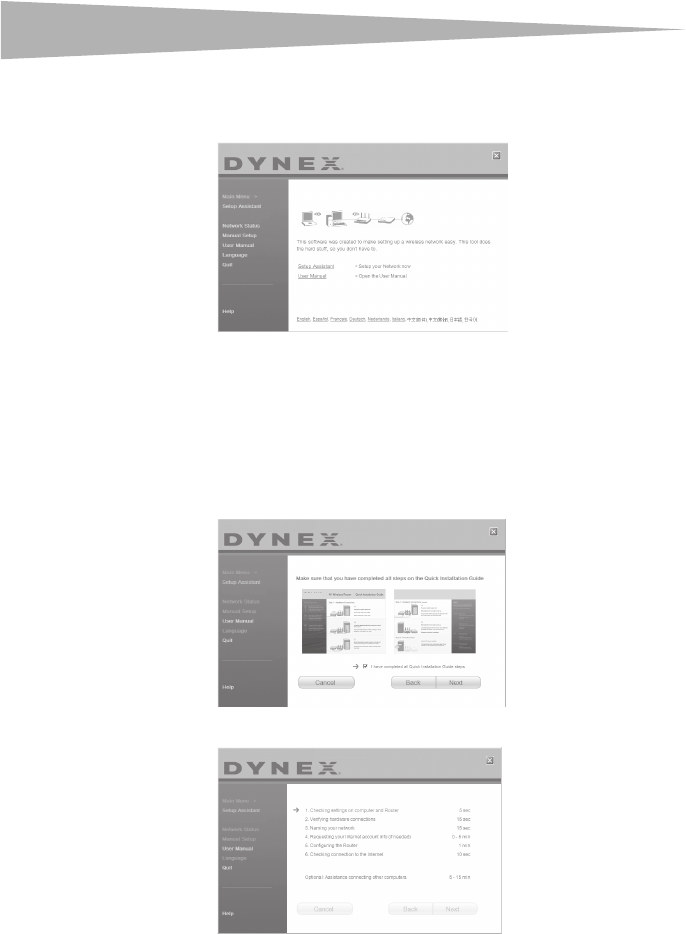
10 Setting up your wireless route
r
3Insert the Installation CD into your computer. The Setup Assistant will automatically
appear on your computer's screen within 15 seconds. Double-click the Setup Assistant
to run it, then follow the on-screen instructions.
Important: Run the Setup Assistant from the computer that is directly connected to the
router.
Note: For Windows users: If the Setup Assistant does not start up automatically, select your
CD/DVD drive from My Computer and double-click the file named Setup Assistant to
start the Setup Assistant.
4When the Confirmation screen opens, verify that you have completed all QIG steps by
checking the box to the right of the arrow, then click Next to continue.
The Setup Assistant will indicate each time a step in the setup has been completed.
DYN EX
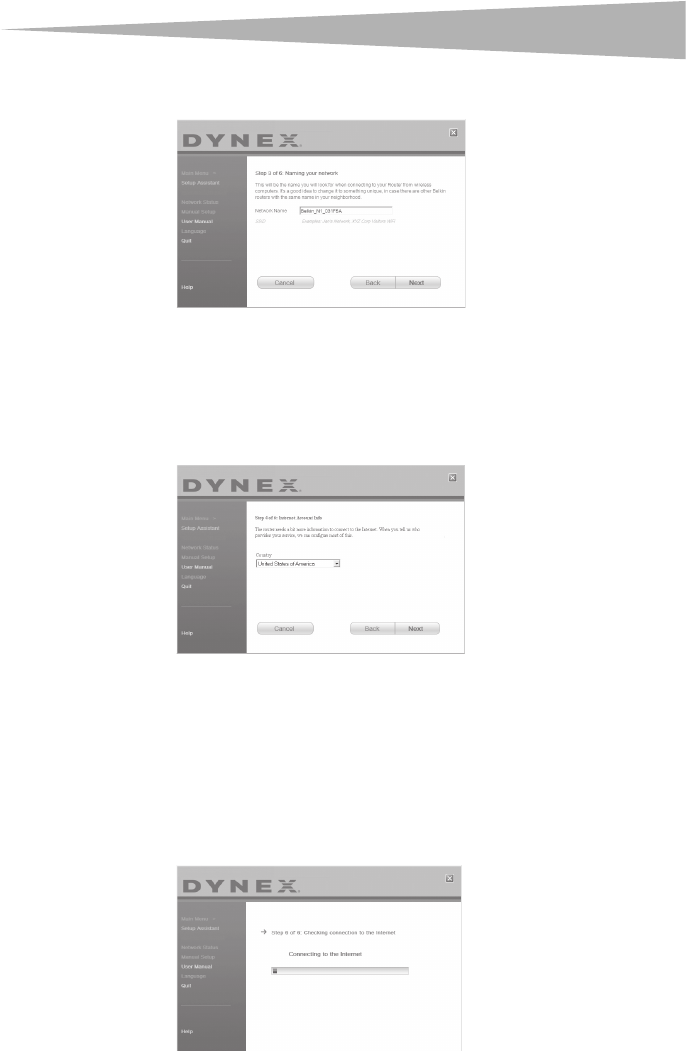
Setting up your wireless route
r
11
When it is time to name your network, the Setup Assistant will open the Naming your
network screen.
The default wireless network name or Service Set Identifier (SSID). This is the name of
your wireless network to which your computers or devices with wireless network
adapters will connect.
5You can either accept the default name or change it to something unique. If you
change it, write down the name for future reference. Click Next to continue. The
Internet Account Info screen opens.
6If your Internet account requires a login and password, you will be prompted with a
screen similar to the illustration above. Select your country or ISP from the lists.
The Setup Assistant will now configure your router by sending data to the router and
restarting it. Wait for the on-screen instructions.
Note: Do not disconnect any cable or power off the router while the router is rebooting. Doing
so will render your router inoperable.
After configuring the router, the Setup Assistant checks your connection to the
Internet.
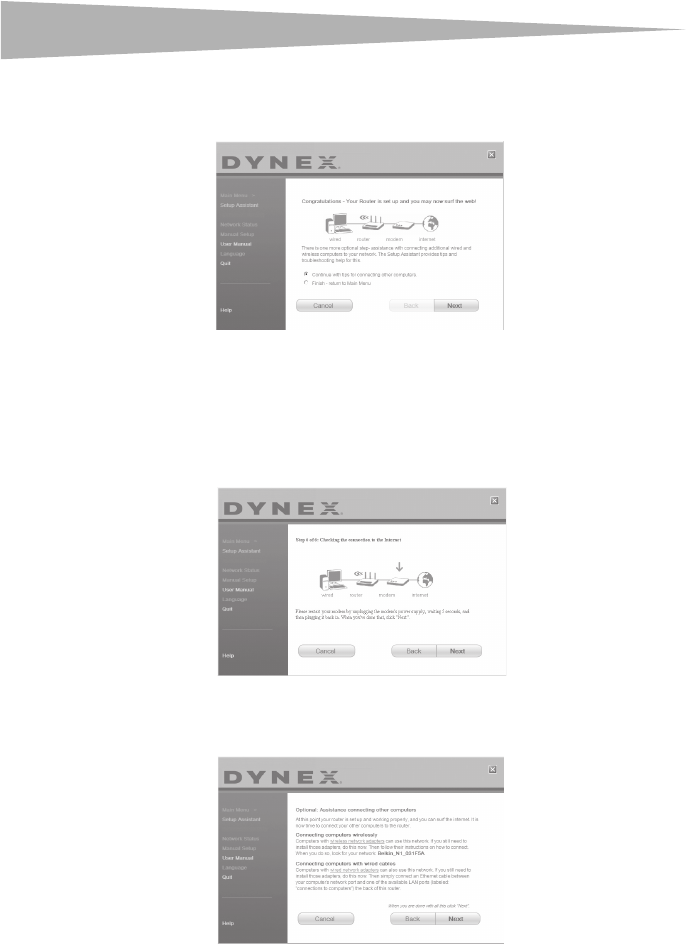
12 Setting up your wireless route
r
This completes the router installation. You will see the Congratulations screen when
your router can connect to the Internet. You can begin surfing by opening your
browser and going to any Web site.
7You can use the Setup Assistant to set up your other wired and wireless computers to
connect to the Internet by clicking Next. If you decide to add computers to your router
later, select Exit the Assistant, then click Next.
To troubleshoot the setup:
1If the Setup Assistant is not able to connect to the Internet, you will see the following
screen. Follow the on-screen instructions to go through the troubleshooting steps.
To use the optional assistance to connect to other computers:
1This optional step will help you to connect additional wired and wireless computers to
your network. Follow the on-screen instructions.
At this point, your router is set up and working properly. It is now time to connect your other
computers.
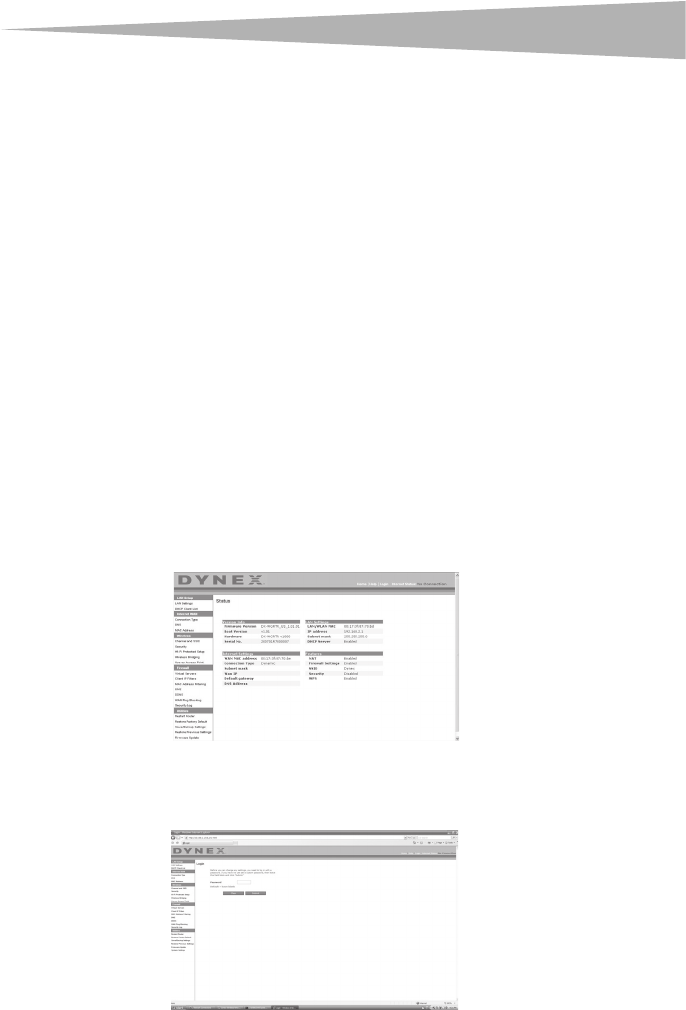
Setting up your wireless route
r
13
Connecting computers wirelessly
Computers with wireless network adapters can use this network. If you still need to install
those adapters, do this now. Then follow their instructions on how to connect. When you do
so, look for your network: John's Home Wi-Fi.
Connecting computers with wired cables
Computers with wired network adapters can use this network. If you still need to install
those adapters, do this now. Then simply connect an Ethernet cable between your
computer's network port and one of the available LAN ports (labeled connections to
computers) on the back of this router.]
Once you have verified that your other wired and wireless computers are properly connected,
your network is set up and working. You can now surf the Internet. Click Next to take you
back to the main menu.
Wireless Security Setup
Be sure to complete the basic setup of your router before setting up security. Make sure that
all of your computers (wired and wireless) can successfully connect to the Internet through
your router.
To set up security:
1On a computer that has a wired (cable) connection to the router, open up a web
browser. In the address field, type 192.168.2.1 (or the IP address you customized),
then click Enter.
2In the menu at left, go to the wireless section and click Security.
If asked to log in, enter your password or, if you have not yet set a custom password,
leave this field blank. Then click, Submit.
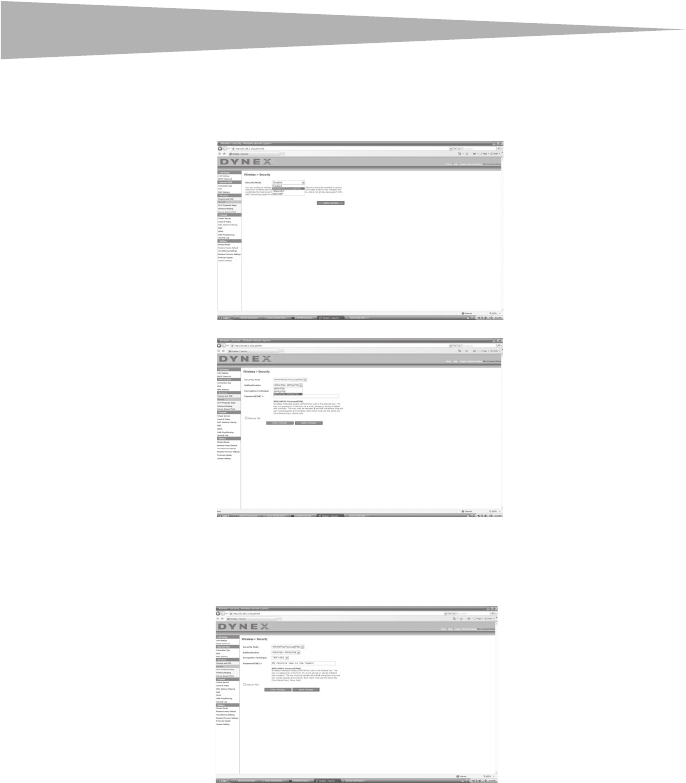
14 Setting up your wireless route
r
3You will be asked to pick a security type. We recommend WPA2-PSK as the security
mode and then WPA-PSK+WPA2-PSK as the Authentication, as it is the most secure
and easiest to use. Once you have made your choice, click Apply Changes.
4In the Pre-shared key field, type a security key that is easy for you to remember. Using
some punctuation will increase your network's security (for example, “My favorite
team is the Tigers!”). Click Apply Changes.
5Now go to each of your wireless computers. Use the wireless utility software on each to
do the following (see you wireless adapter's user manual for more detailed
instructions):
a. Find your wireless network and connect to it.
b. When prompted, enter the phrase you created above.
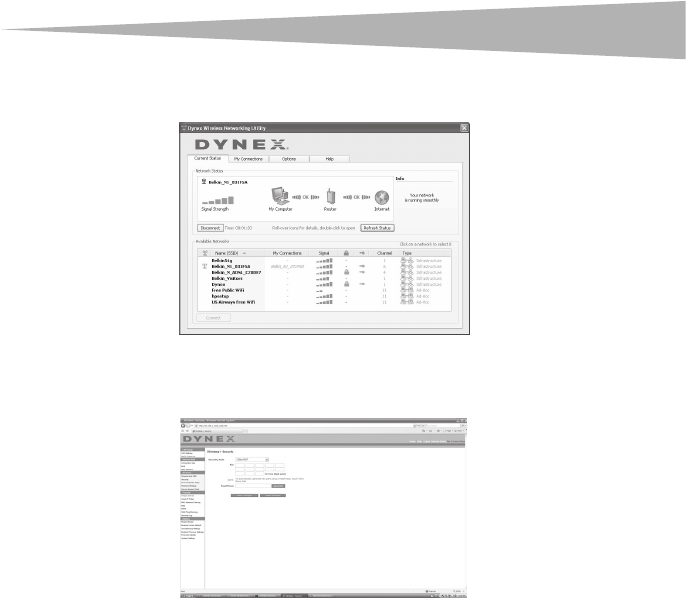
Setting up your wireless route
r
15
Note: If a computer does not accept the phrase, it likely does not yet support WPA/WPA2. Go
to your wireless adapter manufacturer's Web site and check for a driver update.
6If you do not want to update your computer's wireless adapter to work wit h WPA/
WPA2, return to Step 4 and choose WEP. See “WEP Setup” on page 30 for instructions
on setting up WEP.
Alternate setup method
The Web-Based Advanced User Interface is a web-based tool that you can use to set up the
router if you do not want to use the Easy Install Wizard. You can also use it to manage
advanced functions of the router. From the Web-Based Advanced User Interface, you can
perform the following tasks:
• View the router's current settings and status
• Configure the router to connect to your ISP with the settings that they provided you
• Change the current network settings such as the Internal IP address, the IP address
pool, DHCP settings, and more
• Set the router's firewall to work with specific applications (port forwarding)
• Set up security features such as client restrictions, MAC address filtering, WEP, and
WPA
• Enable the DMZ feature for a single computer on your network
• Change the router's internal password
• Enable/Disable UPnP (Universal Plug-and-Play)
• Reset the router
• Back up your configuration settings
• Reset the router's default settings
• Update the router's firmware

16 Setting up your wireless route
r
To connect your router (step 1):
1Turn off the power to your modem by unplugging the power supply from the modem.
2Locate the network cable that is connected between your modem and your computer
and unplug it from your computer, leaving the other end connected to your modem.
3Plug the loose end of the cable you just unplugged into the port on the back of the
router labeled Modem.
4Connect a new network cable (not included) from the back of the computer to one of
the wired computer ports labeled 1-4. Note: It does not matter which numbered port
you choose.
5Turn your cable or DSL modem on by reconnecting the power supply to the modem.
6Plug the power cord into the wall, then plug the cord into the router's power jack.
7Make sure that your modem is connected to the router by checking the lights on the
front of the router. The green light labeled Modem should be on if your modem is
connected correctly to the router. If it is not, recheck your connections.
8Make sure that your computer is connected properly to the router by checking the
lights labeled 1-4. The light that corresponds to the numbered port connected to your
computer should be on if your computer is connected properly. If it is not, recheck your
connections.
To set up your computer's network settings to work with a DHCP server:
• See “Manually configuring network settings” on page 44 for directions.
Configuring the router using the Web-Based Advanced User Interface:
1Open your Internet browser, the access the router's Web-Based Advanced User
Interface by typing “192.168.2.1” in the address line (you do not need to type in
anything else such as “http://” or “www”), then press Enter. The router's home page
opens.
Note: If you have difficulty accessing the router's Web-Based Advanced User Interface, go to
the section entitled “Manually Configuring Network Settings”.
2To make any changes to the router's settings, you have to log in. Click Login, or click
on any one of the links on the home page to go to the login screen.
3In the login screen, leave the password blank (the router ships with no password
entered) and click Submit to log in.
One computer at a time can log into the router for the purposes of making changes to
the settings of the router.
4After you have logged in to make changes, there are two ways that the computer can
be logged out. Clicking Logout will log the computer out.
- OR -
5The login will time out after a specified period of time. The default login time-out is 10
minutes. This can be changed from 1 to 99 minutes. For more information, see
“Changing the Login Time-Out Setting” on page 42.
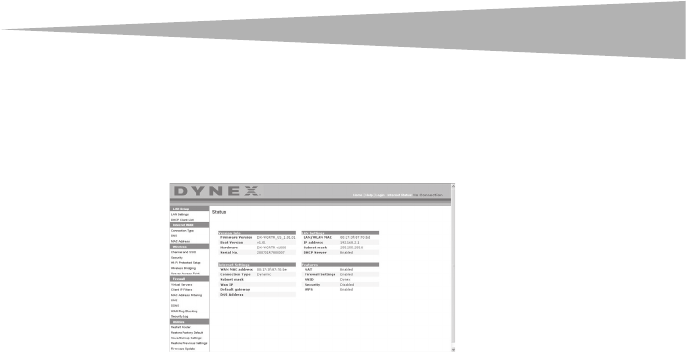
Setting up your wireless route
r
17
Using the Web-Based Advanced User Interface
The home page is the first page you will see when you access the Web-Based Advanced User
Interface (UI). The home page shows you a quick view of the router's status and settings. All
advanced setup pages can be reached from this page.
Quick-Navigation Links—You can go directly to any of the router's UI pages by clicking
directly on these links. The links are divided into logical categories and grouped by tabs to
make finding a particular setting easier to find. Clicking on the purple header of each tab will
show you a short description of the tab's function.
Home Button—The Home button is available in every page of the UI. Pressing this button
will take you back to the home page.
Internet Status Indicator—This indicator is visible in all pages of the UI, indicating the
connection status of the router. When the indicator says connection OK in green, the router
is connected to the Internet. When the router is not connected to the Internet, the indicator
will read no connection in red. The indicator is automatically updated when you make
changes to the settings of the router.
Login/Logout Button—This button enables you to log in and out of the router with the
press of one button. When you are logged into the router, this button will change to read
Logout. Logging into the router will take you to a separate login page where you will need
to enter a password. When you are logged into the router, you can make changes to the
settings. When you are finished making changes, you can log out of the router by clicking the
Logout button.
Help Button—The Help button gives you access to the router's help pages. Help is also
available on many pages by clicking more info next to certain sections of each page.
LAN Settings—Shows you the settings of the Local Area Network (LAN) side of the router.
Changes can be made to the settings by clicking on any one of the links (IP Address, Subnet
Mask, DHCP Server) or by clicking the LAN - Quick Navigation link on the left side of the
screen.
Features—Shows the status of the router's NAT, firewall, and wireless features. Changes
can be made to the settings by clicking on any one of the links or by clicking the Quick
Navigation links on the left side of the screen.
Internet Settings—Shows the settings of the Internet/WAN side of the router that
connects to the Internet. Changes to any of these settings can be made by clicking on the
links or by clicking on the Internet/WAN - Quick Navigation link on the left side of the
screen.
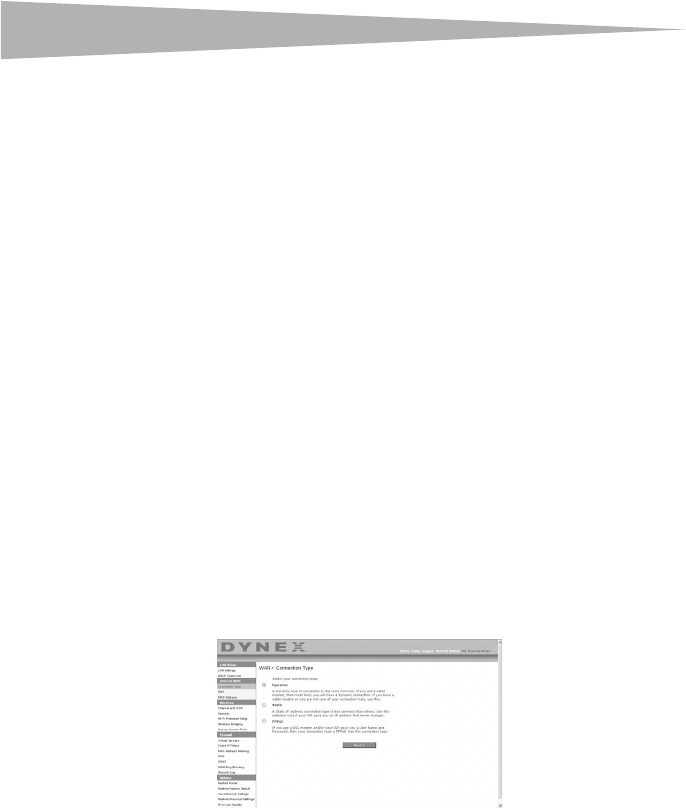
18 Setting up your wireless route
r
Version Info—Shows the firmware version, boot-code version, hardware version, and
serial number of the router.
Page Name—The page you are on can be identified by this name. This User Guide will
sometimes refer to pages by name. For instance LAN > LAN Settings refers to the LAN
Settings page.
Configure your router for connection to your Internet Service
Provider (ISP)
The Internet/WAN tab is where you will set up your router to connect to your Internet
Service Provider (ISP). The router is capable of connecting to virtually any ISP's system
provided you have correctly configured the router's settings for your ISP's connection type.
Your ISP connection settings are provided to you by your ISP.
To configure the router with the settings that your ISP gave you:
1Click Connection Type on the left side of the screen, then select the connection type
you use.
2If your ISP gave you DNS settings, clicking DNS lets you enter DNS address entries for
ISPs that require specific settings.
3Click MAC address to clone your computer's MAC address or type in a specific WAN
MAC address, if required by your ISP.
4When you have finished making settings, the Internet Status indicator will read
connection OK if your router is set up properly.
To set your Connection Type:
1Click Connection Type from the menu on the left side of the screen. The Connection
Type page opens. From this page you can select the type of connection you use by
clicking the button next to your connection type and then clicking Next.
Setting your Internet Service Provider (ISP) Connection Type to Dynamic IP
A dynamic connection type is the most common connection type used with cable modems.
Setting the connection type to dynamic in many cases is enough to complete the
connection to your ISP. Some dynamic connection types may require a host name. You can
enter your host name in the space provided if you were assigned one. Your host name is
assigned by your ISP. Some dynamic connections may require that you clone the MAC address
of the PC that was originally connected to the modem.
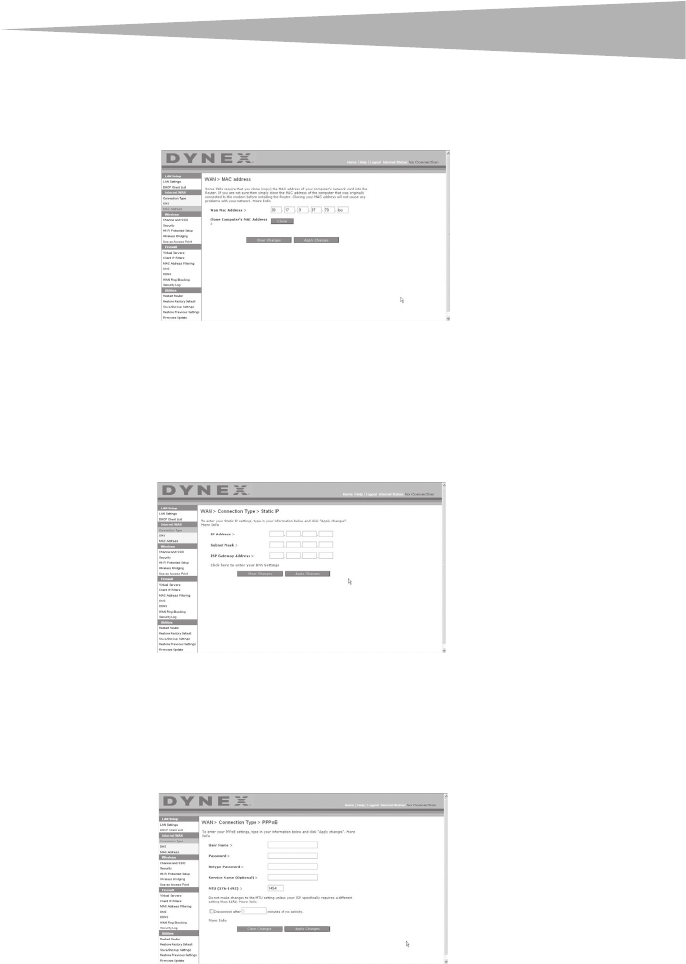
Setting up your wireless route
r
19
Change WAN MAC Address
If your ISP requires a specific MAC address to connect to the service, you can enter a specific
MAC address or clone the current computer's MAC address through this link.
Setting your Internet Service Provider (ISP) Connection Type to Static IP
A static IP address connection type is less common than other connection types. If your ISP
uses static IP addressing, you will need your IP address, subnet mask, and ISP gateway
address. This information is available from your ISP or on the paperwork that your ISP left
with you. Type in your information, then click Apply Changes. After you apply the changes,
the Internet Status indicator will read connection OK if your router is set up correctly.
Setting your ISP Connection Type to PPPoE
Most DSL providers use PPPoE as the connection type. If you use a DSL modem to connect to
the Internet, your ISP may use PPPoE to log you into the service. If you have an Internet
connection in your home or small office that doesn't require a modem, you may also use
PPPoE.

20 Setting up your wireless route
r
Your connection type is PPPoE if:
• Your ISP gave you a user name and password, which is required to connect to the
Internet;
• Your ISP gave you software such as WinPOET or Enternet300 that you use to connect to
the Internet; or
• You have to double-click on a desktop icon other than your browser to get on the
Internet.
Enter the following:
User Name–This space is provided to type in your user name that was assigned by your ISP.
Password–Type in your password and re-type it into the Retype Password box to confirm it.
Service Name–A service name is rarely required by an ISP. If you are not sure if your ISP
requires a service name, leave this blank.
MTU–The MTU setting should never be changed unless your ISP gives you a specific MTU
setting. Making changes to the MTU setting can cause problems with your Internet
connection including disconnection from the Internet, slow Internet access, and problems
with Internet applications working properly.
Disconnect after X minutes…–This feature is used to automatically disconnect the router
from your ISP when there is no activity for a specified period of time. For instance, placing a
check mark next to this option and entering 5 into the minute field will cause the router to
disconnect from the Internet after five minutes of no Internet activity. This option should be
used if you pay for your Internet service by the minute.
Setting Custom Domain Name Server (DNS) Settings
A Domain Name Server is a server located on the Internet that translates Universal Resource
Locators (URLs) like “www.dynex.com” into IP addresses. Many Internet Service Providers
(ISPs) do not require you to enter this information into the router. The Automatic from ISP
box should be checked if your ISP did not give you a specific DNS address. If you are using a
static IP connection type, then you may need to enter a specific DNS address and secondary
DNS address for your connection to work properly. If your connection type is dynamic or
PPPoE, it is likely that you do not have to enter a DNS address. Leave the Automatic from
ISP box checked. To enter the DNS address settings, uncheck the Automatic from ISP box
and enter your DNS entries in the spaces provided. Click Apply Changes to save the settings.

Setting up your wireless route
r
21
Configuring your WAN Media Access Controller (MAC) Address
All network components including cards, adapters, and routers, have a unique “serial
number” called a MAC address. Your Internet Service Provider may record the MAC address of
your computer's adapter and only let that particular computer connect to the Internet
service. When you install the router, its own MAC address will be “seen” by the ISP and may
cause the connection not to work. Dynex has provided the ability to clone (copy) the MAC
address of the computer into the router. This MAC address, in turn, will be seen by the ISP's
system as the original MAC address and will allow the connection to work. If you are not sure
whether your ISP needs to see the original MAC address, simply clone the MAC address of the
computer that was originally connected to the modem. Cloning the address will not cause
any problems with your network.
To clone your MAC Address:
1Make sure that you are using the computer that was ORIGINALLY CONNECTED to your
modem before the router was installed. Click
2Click Clone, then click Apply Changes. Your MAC address is now cloned to the router.
To enter a specific MAC Address:
• Type in a MAC address in the spaces provided, then click Apply Changes to save the
changes. The router's WAN MAC address is changed to the MAC address you specified.
Using the Web-Based Advanced User Interface
Using your Internet browser, you can access the router's Web-Based Advanced User Interface.
Open your browser and enter 192.168.2.1 (do not type in anything else such as “http://
” or “www”), then press Enter. The router's home page opens in your browser window.
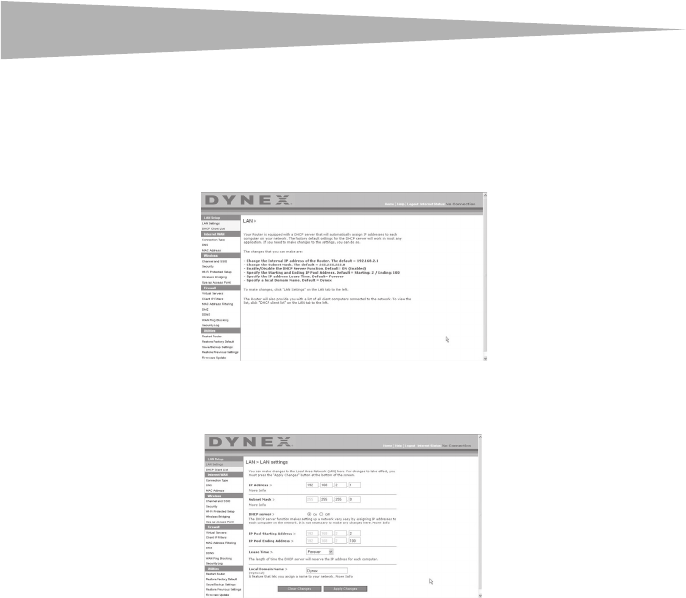
22 Setting up your wireless route
r
Viewing the LAN Settings
Clicking on the header of the LAN Setup tab will take you its header page. A quick
description of the functions can be found here. To view the settings or make changes to any
of the LAN settings, click LAN Settings, or to view the list of connected computers, click
DHCP Client List.
Changing LAN Settings
All settings for the internal LAN setup of the router can be viewed and changed here.
IP Address–The IP address is the internal IP address of the router. The default IP address is
192.168.2.1. To access the Web-Based Advanced User Interface, type this IP address into the
address bar of your browser. This address can be changed if needed. To change the IP address,
type in the new IP address and click Apply Changes. The IP address you choose should be a
non-routable IP.
Examples of a non-routable IP are: 192.168.x.x (where x is anywhere between 0 and 255),
and 10.x.x.x (where x is anything between 0 and 255).
Subnet Mask–There is no need to change the subnet mask. This is a unique, advanced
feature of your Dynex router. It is possible to change the subnet mask if necessary; however,
do NOT make changes to the subnet mask unless you have a specific reason to do so. The
default setting is 255.255.255.0.
DHCP Server–The DHCP server function makes setting up a network very easy by assigning
IP addresses to each computer on the network automatically. The default setting is On. The
DHCP server can be turned OFF if necessary; however, in order to do so you must manually set
a static IP address for each computer on your network. To turn off the DHCP server, select Off,
then click Apply Changes.

Setting up your wireless route
r
23
IP Pool–The range of IP addresses set aside for dynamic assignment to the computers on
your network. The default is 2-100 (99 computers). If you want to change this number, you
can do so by entering a new starting and ending IP address and clicking Apply Changes.
The DHCP server can assign 100 IP addresses automatically. This means that you cannot
specify an IP address pool larger than 100 computers. For example, starting at 50 means you
have to end at 150 or lower so as not to exceed the 100-client limit. The starting IP address
must be lower in number than the ending IP address.
Lease Time–The length of time the DHCP server will reserve the IP address for each
computer. We recommend that you leave the lease time set to Forever. The default setting is
Forever, meaning that any time a computer is assigned an IP address by the DHCP server,
the IP address will not change for that particular computer. Setting lease times for shorter
intervals such as one day or one hour frees IP addresses after the specified period of time.
This also means that a particular computer's IP address may change over time. If you have set
any of the other advanced features of the router such as DMZ or client IP filters, these are
dependent on the IP address. For this reason, you will not want the IP address to change.
Local Domain Name–The default setting is Dynex. You can set a local domain name
(network name) for your network. There is no need to change this setting unless you have a
specific advanced need to do so. You can name the network anything you want such as “MY
NETWORK”.
Viewing the DHCP Client List Page
You can view a list of the computers (known as clients), which are connected to your
network. You are able to view the IP address of the computer, the host name (if the computer
has been assigned one), and the MAC address of the computer's network interface card (NIC).
Pressing the Refresh button will update the list. If there have been any changes, the list will
be updated.
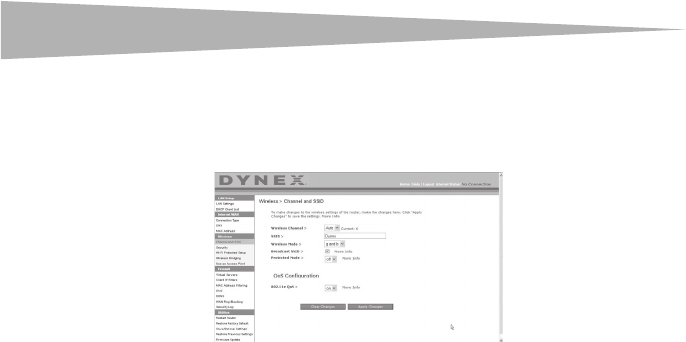
24 Setting up your wireless route
r
Configuring the Wireless Network Settings
Clicking on the header of the Wireless tab will take you to the Wireless page. Under the
Wireless tab, there are links that allow you to make changes to the wireless network
settings.
Changing the Wireless Network Name (SSID)
To identify your wireless network, an SSID (Service Set Identifier) is used. The default SSID of
the router is “Dynex”. You can change this to anything you want to or you can leave it
unchanged. If there are other wireless networks operating in your area, you will want to
make sure that your SSID is unique (does not match that of another wireless network in the
area). To change the SSID, type in the SSID that you want to use in the SSID field and click
Apply Changes. The change is immediate. If you make a change to the SSID, your
wireless-equipped computers may also need to be reconfigured to connect to your new
network name. Refer to the documentation of your wireless network adapter for information
on making this change.
Using the Wireless Mode Switch
Your router can operate in three different wireless modes: “g and b”, “g only”, and “b only”.
The different modes are explained below.
g and b Mode–In this mode, the router is compatible with 802.11b and 802.11g wireless
clients simultaneously. This is the factory default mode and ensures successful operation
with all Wi-Fi-compatible devices. If you have a mix of 802.11b and 802.11g clients in your
network, we recommend setting the router to g and b mode. This setting should only be
changed if you have a specific reason to do so.
g only Mode–g only mode works with 802.11g clients only. This mode is recommended
only if you want to prevent 802.11b clients from accessing your network. To switch modes,
select the desired mode from the Wireless Mode list, then click Apply Changes.
b only Mode–We recommend you DO NOT use this mode unless you have a very specific
reason to do so. This mode exists only to solve unique problems that may occur with some
802.11b client adapters and is NOT necessary for interoperability of 802.11g and 802.11b
standards.

Setting up your wireless route
r
25
When to use b only Mode
In some cases, older 802.11b clients may not be compatible with 802.11g wireless. These
adapters tend to be of inferior design and may use older drivers or technology. Switching to
this mode can solve problems that sometimes occur with these clients. If you suspect that
you are using a client adapter that falls into this category of adapters, first check with the
adapter vendor to see if there is a driver update. If there is no driver update available,
switching to b only mode may fix your problem. Please note that switching to b only mode
will decrease 802.11g performance.
Enhanced G Mode*–The router supports two high-speed modes, 125 Enhanced G mode
and frame-bursting mode.
Selecting 125 Enhanced G mode will result in all devices running in 125 Enhanced G mode if
all devices are capable of 125 Mbps speeds. If any non-125 Enhanced G devices connect or
associates with the network, the router will automatically shift the entire network back to
frame-bursting mode.
Selecting Frame Bursting results in all devices capable of frame-bursting to function in
frame-bursting mode, and all clients not capable, to operate in normal 802.11g modes.
frame-bursting mode supports both frame-bursting-enabled devices and
non-frame-bursting-enabled devices simultaneously. Frame-bursting mode is based on the
unreleased 802.11e specification.
Selecting Off will disable Turbo mode.
*When operating in 125 Enhanced G Mode, this Wi-Fi device achieves an actual throughput
of up to 34.1 Mbps, which is the equivalent throughput of a system following 802.11g
protocol and operating at a signaling rate of 125 Mbps. Actual throughput will vary
depending on environmental, operational, and other factors.
QoS (Quality of Service) Configuration–QoS prioritizes important data on your network
such as multimedia content and Voice over IP (VoIP) so it will not be interfered with by other
data being sent over the network. Based on 802.11e, you can turn this feature on or off by
selecting it from the drop-down menu (3) and choosing the acknowledgement mode you
want to use. If you plan to stream multimedia content or use VoIP on your network, we
recommend that you enable the QoS feature.
Changing the Wireless Channel
There are a number of operating channels you can choose from. In the United States, there
are 11 channels. In Australia, the United Kingdom, and most of Europe, there are 13
channels. In a small number of other countries, there are other channel requirements. Your
router is configured to operate on the proper channels for the country you reside in. The
default channel is 11 (unless you are in a country that does not allow channel 11). The
channel can be changed if needed. If there are other wireless networks operating in your
area, your network should be set to operate on a channel that is different than the other
wireless networks. For best performance, use a channel that is at least five channels away
from the other wireless network. For instance, if another network is operating on channel 11,
then set your network to channel 6 or below. To change the channel, select the channel from
the list, then click Apply Changes. The change is immediate.

26 Setting up your wireless route
r
Using the Broadcast SSID Feature
Note: This advanced feature should be employed by advanced users only.
For security, you can choose not to broadcast your network's SSID. Doing so will keep your
network name hidden from computers that are scanning for the presence of wireless
networks. To turn off the broadcast of the SSID, remove the check mark from the box next to
Broadcast SSID, then click Apply Changes. The change is immediate. Each computer now
needs to be set to connect to your specific SSID; an SSID of ANY will no longer be accepted.
Refer to the documentation of your wireless network adapter for information on making this
change.
Protected Mode Switch–As part of the 802.11g specification, Protected mode ensures
proper operation of 802.11g clients and access points when there is heavy 802.11b traffic in
the operating environment. When Protected mode is ON, 802.11g scans for other wireless
network traffic before it transmits data. Therefore, using this mode in environments with
HEAVY 802.11b traffic or interference achieves best performance results. If you are in an
environment with very little-or no-other wireless network traffic, your best performance will
be achieved with Protected mode OFF.
Securing your Wi-Fi® Network
Here are a few different ways you can maximize the security of your wireless network and
protect your data from prying eyes and ears. This section is intended for the home, home
office, and small office user.
At the time of this User Manual's publication, there are four encryption methods available.
Name
64-Bit Wired
Equivalent
Privacy
128-Bit Wired
Equivalent
Privacy
Wi-Fi Protected
Access-TKIP
Wi-Fi Protected
Access 2
Acronym 64-bit WEP 128-bit WEP WPA-TKIP/AES (or just
WPA) WPA2-AES (or just
WPA2)
Security Good Better Best Best
Features
Static keys Static keys Dynamic key
encryption and
mutual
authentication
Dynamic key
encryption and
mutual
authentication
Encryption keys based
on RC4 algorithm
(typically 40-bit keys)
More secure than
64-bit WEP using a
key length of 104 bits
plus 24 additional bits
of system generated
data
TKIP (Temporal Key
Integrity Protocol)
added so that keys are
rotated and
encryption is
strengthened
AES (Advanced
Encryption Standard)
does not cause any
throughput loss

Setting up your wireless route
r
27
Wired Equivalent Privacy (WEP)
WEP is a common protocol that adds security to all Wi-Fi-compliant wireless products. WEP
gives wireless networks the equivalent level of privacy protection as a comparable wired
network.
64-Bit WEP—64-bit WEP was first introduced with 64-bit encryption, which includes a key
length of 40 bits plus 24 additional bits of system-generated data (64 bits total). Some
hardware manufacturers refer to 64-bit as 40-bit encryption. Shortly after the technology
was introduced, researchers found that 64-bit encryption was too easy to decode.
128-Bit Encryption—As a result of 64-bit WEP’s potential security weaknesses, a more
secure method of 128-bit encryption was developed. 128-bit encryption includes a key
length of 104 bits plus 24 additional bits of system-generated data (128 bits total). Some
hardware manufacturers refer to 128-bit as 104-bit encryption. Most of the new wireless
equipment in the market today supports both 64-bit and 128-bit WEP encryption, but you
might have older equipment that only supports 64-bit WEP. All wireless products from Dynex
will support both 64-bit and 128-bit WEP.
Encryption Keys—After selecting either the 64-bit or 128-bit WEP encryption mode, it is
critical that you generate an encryption key. If the encryption key is not consistent
throughout the entire wireless network, your wireless networking devices will be unable to
communicate with one another. You can enter your key by typing in the hex key manually, or
you can type a passphrase into the Passphrase field, then click Generate to create a key. A
hex (hexadecimal) key is a combination of numbers and letters from A–F and 0–9. For 64-bit
WEP, you need to enter 10 hex keys. For 128-bit WEP, you need to enter 26 hex keys.
For instance:
AF 0F 4B C3 D4 = 64-bit WEP key
C3 03 0F AF 0F 4B B2 C3 D4 4B C3 D4 E7 = 128-bit WEP key
The WEP passphrase is NOT the same as a WEP key. Your card uses this passphrase to
generate your WEP keys, but different hardware manufacturers might have different
methods on generating the keys. If you have multiple vendors’ equipment in your network,
the easiest thing to do is to use the hex WEP key from your wireless router and enter it
manually into the hex WEP key table in your card’s configuration screen.
Security Sync (WPS)
Your router is equipped with the latest security standard, called Wi-Fi Protected Access
(WPA2), and the legacy security standard, called Wired Equivalent Privacy (WEP). Your router
also supports the Wi-Fi Protected Setup (WPS) specification, which simplifies the setup of a
wireless network. WPS uses familiar methodologies, such as typing in a Personal
Identification Number (PIN) or pushing a button, to enable users to automatically configure
network names and strong WPA/WPA2 data encryption and authentication. By default,
wireless security is disabled. To enable security, you need to determine which standard you
want to use. To access the security settings, click Security on the Wireless tab.
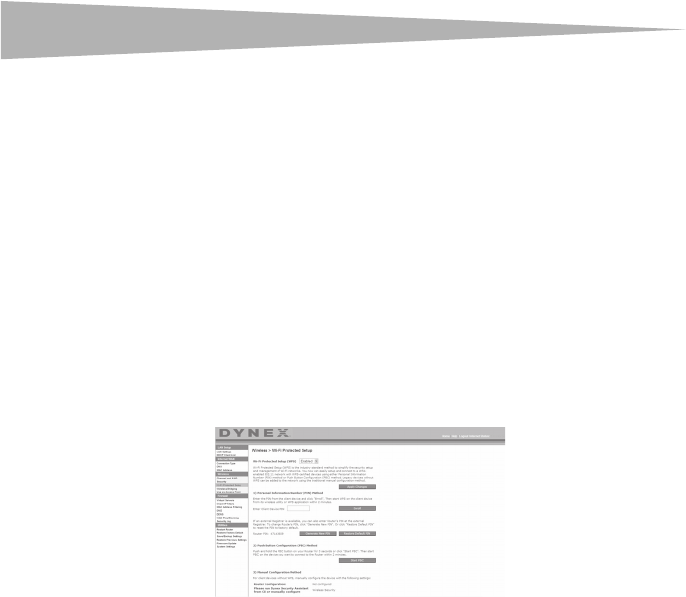
28 Setting up your wireless route
r
Using Security Sync (Wi-Fi Protected Setup)
Security Sync (WPS) uses WPA2 for encryption. It does not provide additional security, but
rather, standardizes the method for securing your wireless network. You may use either the
Push Button Configuration (PBC) method or PIN method to let a device access to your
wireless network. Conceptually, the two methods work as follows:
PBC: Push and hold the Security Sync (WPS) button located on the top of your router for
three seconds. Then initiate the Security Sync (WPS) procedure on the client device within
two minutes. Your client will automatically exchange the security information and be added
to your wireless network. The client has now been securely added to your wireless network.
Pushing the Security Sync button will automatically enable WPS. The PBC method can also
be initiated from the notebook computer.
PIN: The client device has a PIN number (either four or eight digits) that is associated with
WPS. Enable WPS through the GUI shown below. Enter the client's PIN into the Router's
internal registrar (accessed through this GUI). The client will be automatically enrolled into
your wireless network within two minutes.
1. Wi-Fi Protected Setup (WPS): Enabled or Disabled.
2. Personal Identification Number (PIN) Method: In this method, a wireless client wishing to
access your network must supply a 4- or 8-digit PIN to the router. After clicking "Enroll",
you must start the WPS handshaking procedure from the client within two minutes.
3. Router PIN: If an external registrar is available, you can enter in the router's PIN to the
registrar. Click Generate New PIN to change the PIN from the default value, or click
Restore Default PIN to reset the PIN value.
4. Push Button Configuration (PBC) Method: PBC is an alternate method to connect to a
WPS network. Push the Security Sync button located on the back of the router for three
seconds, and then initiate the PBC on the client device. Alternatively, push the "Start
PBC" soft button to start this process.
5. Manual Configuration Method: This section lists the default security settings if not using
WPS.
Therouter features WPA2, which is the second generation of the WPA-based 802.11i
standard. It offers a higher level of wireless security by combining advanced network
authentication and stronger Advanced Encryption Standard (AES) encryption methods.

Setting up your wireless route
r
29
Wi-Fi Protected Areas (WPA)
WPA is a new Wi-Fi standard that improves upon the security features of WEP. To use WPA
security, the drivers and software of your wireless equipment must be upgraded to support
it. These updates will be found on your wireless vendor’s Web site. There are three types of
WPA security: WPA-PSK (no server), WPA (with radius server), and WPA2.
WPA-PSK (no server) uses what is known as a pre-shared key as the network key. A
network key is a password that is between eight and 63 characters long. It can be a
combination of letters, numbers, or characters. Each client uses the same network key to
access the network. Typically, this is the mode that will be used in a home environment.
WPA (with radius server) is a system where a radius server distributes the network key to
the clients automatically. This is typically found in a business environment.
WPA2 requires Advanced Encryption Standard (AES) for encryption of data, which offers
much greater security than WPA. WPA uses both Temporal Key Integrity Protocol (TKIP) and
AES for encryption.
Most Wi-Fi products ship with security turned off. So once you have your network working,
you need to activate WEP or WPA and make sure all your wireless devices are sharing the
same network key.
IMPORTANT: You must now set all wireless network cards/adapters to match these settings.
Sharing the Same Network Keys
Most Wi-Fi products ship with security turned off. So once you have your network working,
you need to activate WEP or WPA and make sure your wireless networking devices are
sharing the same network key.
The Wireless G Desktop Card cannot access the network because it is using a different
network key than the network key that is configured on the wireless enhanced G router.
Using a Hexadecimal Key
A hexadecimal key is a combination of numbers and letters from A-F and 0-9. 64-bit keys are
five two-digit numbers. 128-bit keys are 13 two-digit numbers.
For instance:
AF 0F 4B C3 D4 = 64-bit key
C3 03 0F AF 0F 4B B2 C3 D4 4B C3 D4 E7 = 128-bit key
Note to Mac users: Original Apple® AirPort® products support 64-bit encryption only. Apple
AirPort 2 products can support 64-bit or 128-bit encryption. Please check your product to
see which version you are using. If you cannot configure your network with 128-bit
encryption, try 64-bit encryption.

30 Setting up your wireless route
r
WEP Setup
To set up 64-Bit WEP encryption:
1Click Security under the Wireless heading on the left menu. The Wireless > Security
page opens.
2Select 64-bit WEP from the Security Mode list.
3Enter your key by typing in the hex key manually, or you can put a check mark in
Passphrase, then type in your passphrase.
4Click Generate to generate four different hex keys.
A hex (hexadecimal) key is a combination of numbers and letters from A-F and 0-9. For
64-bit WEP, you need to enter 10 hex characters.
For example: AF 0F 4B C3 D4 = 64-bit WEP key
5Click Apply Changes to save the setting.
Caution: If you are configuring the wireless enhanced G router or access point from a
computer with a wireless client, you will need to make sure that security is turned ON for
this wireless client. If this is not done, your client will lose its wireless connection.
To set up 128-Bit WEP encryption:
Note to Mac users: The passphrase option will not operate with Apple AirPort. To configure
encryption for your Mac computer, set the encryption using the manual method described
in the next section.
1Click Security under the Wireless heading on the left menu. The Wireless Security
page opens.
2Select 128-bit WEP from the Security Mode list.
3Enter your key by typing in the hex key manually, or you can put a check mark in
Passphrase, then type in your passphrase.
4Click Generate to generate four different hex keys.
A hex (hexadecimal) key is a combination of numbers and letters from A-F and 0-9. For
128-bit WEP, you need to enter 26 hex characters.
For example: C3 03 0F AF 0F 4B B2 C3 D4 4B C3 D4 E7 = 128-bit WEP key
5Click Apply Changes to save the setting.
Caution: If you are configuring the wireless enhanced G router or access point from a
computer with a wireless client, you will need to make sure that security is turned ON for
this wireless client. If this is not done, your client will lose its wireless connection.
Changing the Wireless Security Settings
Your router is equipped with WPA (Wi-Fi Protected Access), the latest wireless security
standard. It also supports the legacy security standard, WEP (Wired Equivalent Privacy). By
default, wireless security is disabled. To enable security, you must first determine which
standard you want to use. To access the security settings, click Security under the Wireless
heading on the left menu.

Setting up your wireless route
r
31
WPA Setup
Note: To use WPA security, all your clients must be upgraded to drivers and software that
support it. At the time of this User Manual's publication, a security patch download is
available, for free, from Microsoft®. This patch works only with the Windows XP operating
system. You also need to download the latest driver for your Dynex Wireless Enhanced G
Desktop or Notebook Network Card from the Dynex support site. Other operating systems
are not supported at this time. Microsoft's patch only supports devices with WPA-enabled
drivers such as Dynex 802.11g products.
WPA uses a so-called pre-shared key as the security key. A pre-shared key is a password that
is between eight and 63 characters long. It can be a combination of letters, numbers, and
other characters. Each client uses the same key to access the network. Typically, this mode
will be used in a home environment.
WPA2 is the second generation of WPA, offering a more advanced encryption technique over
WPA.
To set up WPA/WPA2:
1Click Security under the Wireless heading on the left menu. The Wireless > Security
page opens.
2Select WPA/WPA2-Personal (PSK) from the Security Mode list.
3Select WPA-PSK for just WPA authentication, or WPA2-PSK for just WPA2
authentication, or you may select WPA-PSK + WPA2-PSK for WPA and WPA2 as the
authentication type.
4Enter your pre-shared key. This can be from eight to 63 characters and can be letters,
numbers, or symbols. This same key must be used on all of the clients that you set up.
This pre-shared key will allow users full access to your network including shared files
and printers.
5Click Apply Changes to finish. You must now set all clients to match these settings
depending on the type of access you want them to have.
Note: If your wireless card is not equipped with WPA-enabled software, a file from Microsoft
called Windows XP Support Patch for Wireless Protected Access is available for free
download.
The file that Microsoft has made available works only with Windows XP. Other operating
systems are not supported at this time.
Important: You also need to ensure that the wireless card manufacturer supports WPA and
that you have downloaded and installed the latest driver from their support site.
To set up Windows XP Wireless Network Utility to use WPA-PSK:
1Under Windows XP, click Start, Control Panel, Network Connections.
2Right-click Wireless Network Connection Properties, then click Properties.
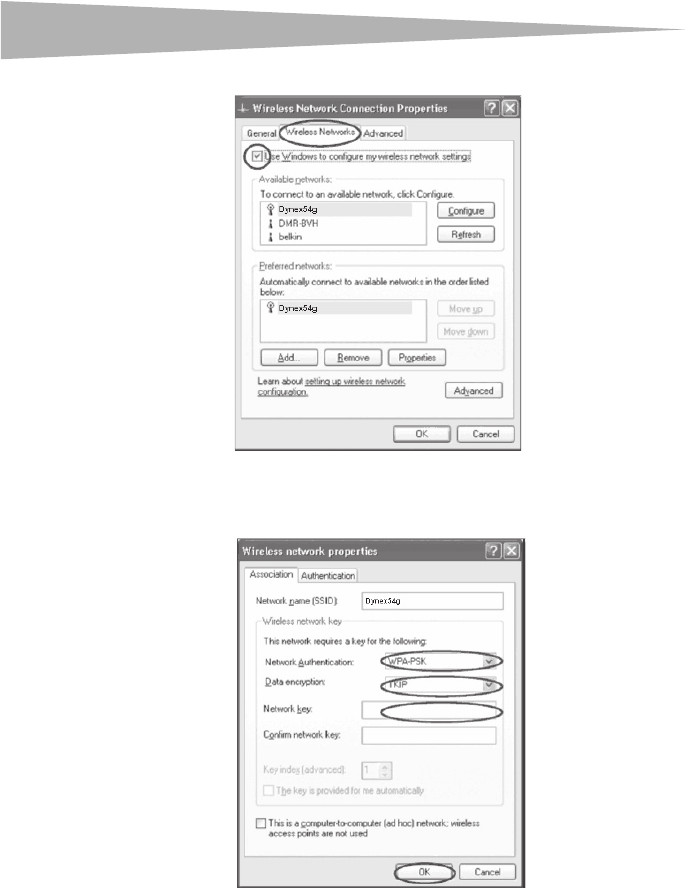
32 Setting up your wireless route
r
3Click the Wireless Networks tab. The following screen opens.
4Make sure that the Use Windows to configure my wireless network settings box
is checked.
5Click the Wireless Networks tab, then click Configure. The following screen opens.
6For a home or small business user, select WPA-PSK under Network Authentication.
Note: Select WPA if you are using this computer to connect to a corporate network that
supports an authentication server such as a radius server. Consult your network
administrator for further information.
7Select TKIP or AES under Data Encryption. This setting must be identical to the
router that you set up.
8Type in your encryption key in the Network key box.
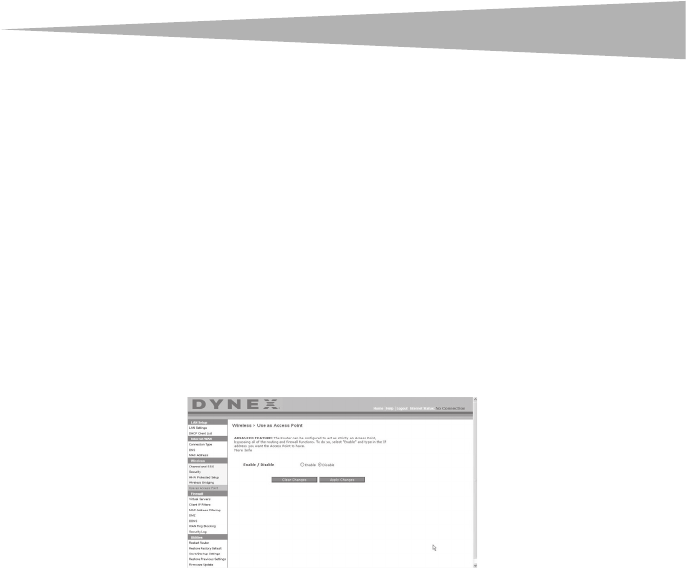
Setting up your wireless route
r
33
Important: Enter your pre-shared key. This can be from eight to 63 characters and can be
letters, numbers, or symbols. This same key must be used on all of the clients that you set
up.
9Click OK to apply settings.
Using the Access Point Mode
Note: This advanced feature should be employed by advanced users only. The router can be
configured to work as a wireless network access point. Using this mode will defeat the NAT
IP sharing feature and DHCP server. In Access Point (AP) mode, the router will need to be
configured with an IP address that is in the same subnet as the rest of the network that
you will bridge to. The default IP address is 192.168.2.254 and subnet mask is
255.255.255.0. These can be customized for your needs.
To use the Access Point mode:
1Click Use as access point under the Wireless heading on the left menu. The Wireless
> Use as Access Point page opens.
2Select Enable. When you select this option, you will be able to change the IP settings.
3Set your IP settings to match your network, then click Apply Changes.
4Connect a cable from the Modem port on the router to your existing network.
The router is now acting as an access point. To access the router's Web-Based
Advanced User Interface again, type the IP address you specified into your browser's
navigation bar. You can set the encryption settings, MAC address filtering, SSID, and
channel normally.
Configuring the Firewall
Your router is equipped with a firewall that will protect your network from a wide array of
common hacker attacks including:
• IP Spoofing
• SYN flood
•Land Attack
• UDP flooding
• Ping of Death (PoD)
• Tear Drop Attack
• Denial of Service (DoS)
•ICMP defect
•IP with zero length
•RIP defect